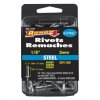G
glenbo
I just used waterproof silicone sealant and did the same on my previous bike. Never became loose in 5 winters of riding so am pretty sure the one on the NC is going no where.
I used 3M double-sided sticky tape that's really super sticky. It is fixed hard onto the fender, I don't think I could pry it off without doing some damage. After being on there 3 months, it's not going to come loose unless I ride in an extended flood.








